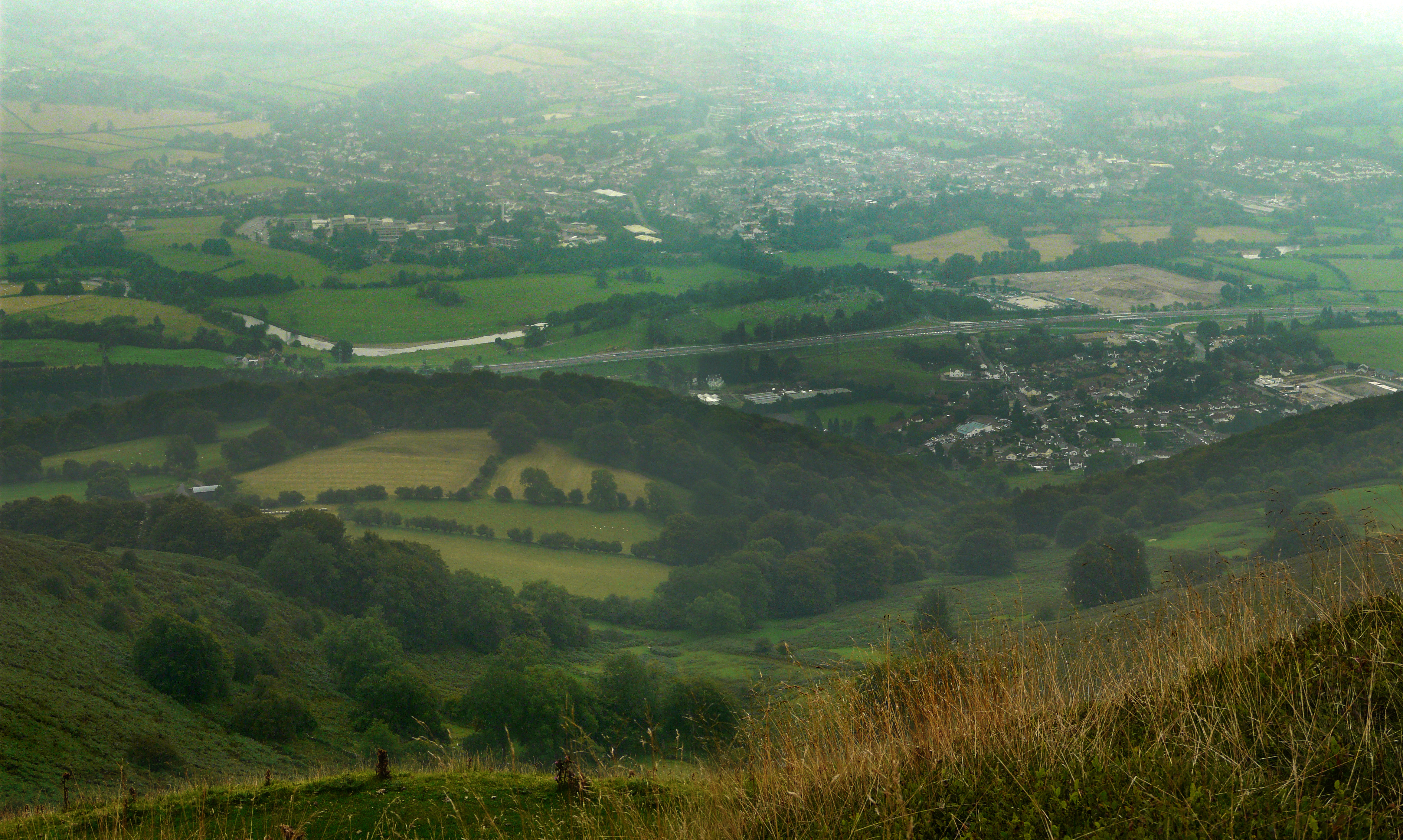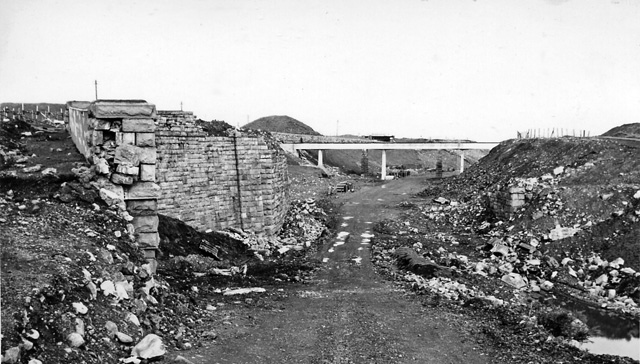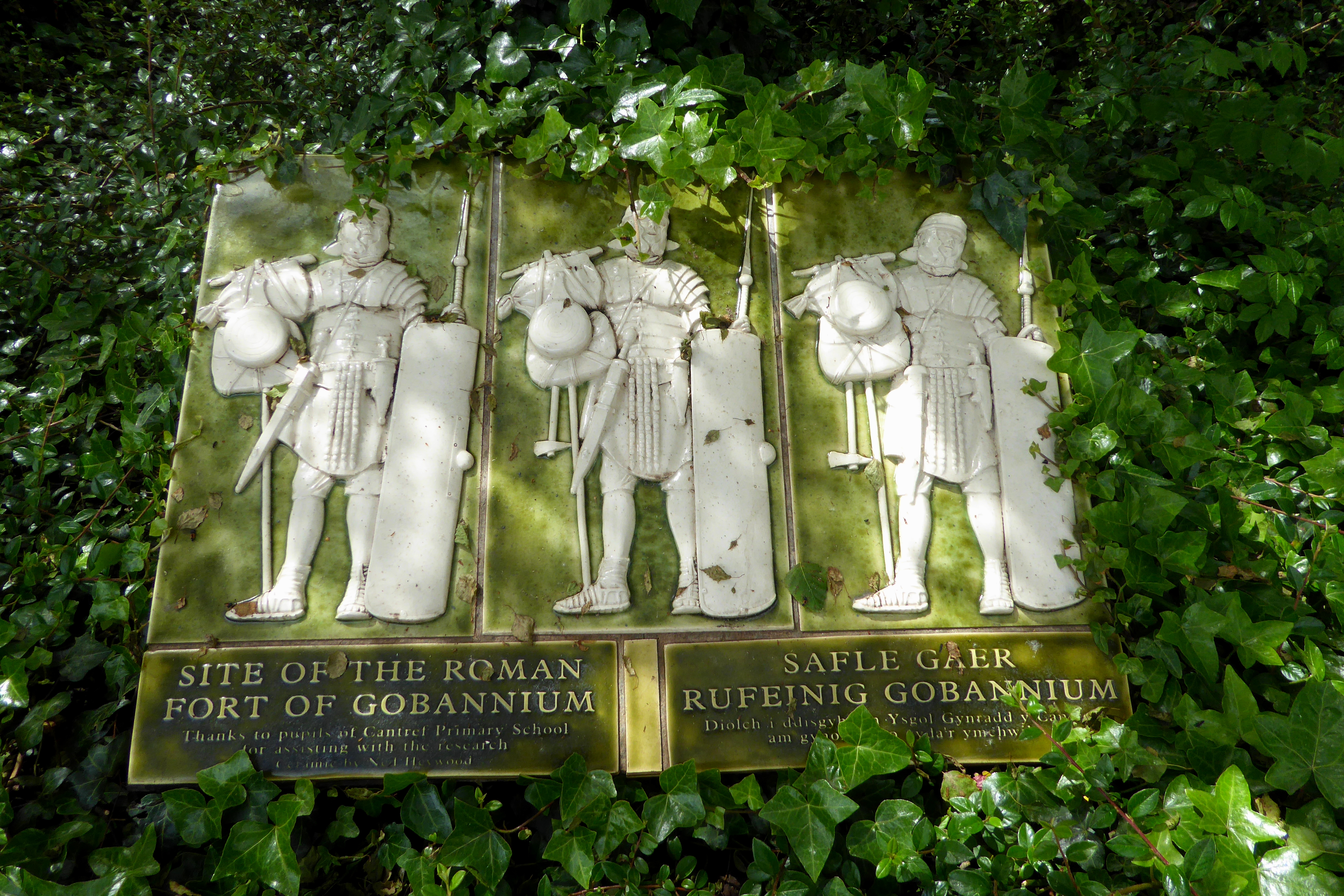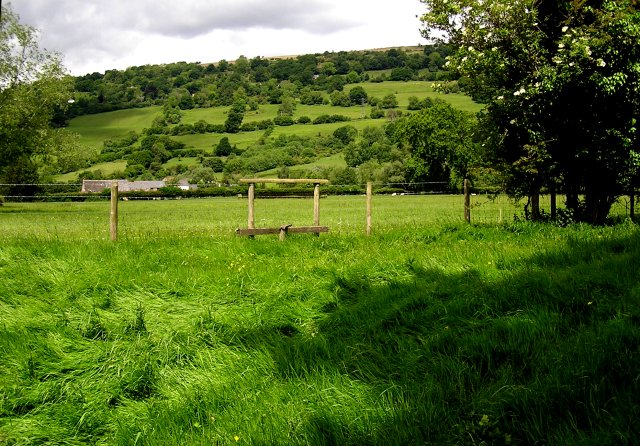|
Abergavenny
Abergavenny (; cy, Y Fenni , archaically ''Abergafenni'' meaning "mouth of the River Gavenny") is a market town and community in Monmouthshire, Wales. Abergavenny is promoted as a ''Gateway to Wales''; it is approximately from the border with England and is located where the A40 trunk road and the A465 Heads of the Valleys road meet. Originally the site of a Roman fort, Gobannium, it became a medieval walled town within the Welsh Marches. The town contains the remains of a medieval stone castle built soon after the Norman conquest of Wales. Abergavenny is situated at the confluence of the River Usk and a tributary stream, the Gavenny. It is almost entirely surrounded by mountains and hills: the Blorenge (), the Sugar Loaf (), Ysgyryd Fawr (Great Skirrid), Ysgyryd Fach (Little Skirrid), Deri, Rholben and Mynydd Llanwenarth, known locally as " Llanwenarth Breast". Abergavenny provides access to the nearby Black Mountains and the Brecon Beacons National Park. The M ... [...More Info...] [...Related Items...] OR: [Wikipedia] [Google] [Baidu] |
Abergavenny Town Hall
Abergavenny Town Hall ( cy, Neuadd y Dref Y Fenni) is a municipal building located on Cross Street, Abergavenny in Monmouthshire, Wales. The town hall, which also houses the town's market, is a Grade II listed building. History The first building on the site was a market hall which had been financed by a legacy from the local member of parliament, Philip Jones, and which was completed in the early 17th century. Following their appointment in 1794, one of the first acts of the new Abergavenny Improvement Commissioners was to commission a new market hall which was designed by the well-known Regency and Georgian era architect, John Nash, and completed in 1796. In the 1860s, in anticipation of a further increases in their responsibilities, including those of an urban sanitary authority, the commissioners decided to procure a town hall which would be built on the same site. Construction of the new building, which was built with old red sandstone with Bath limestone and slate roof ... [...More Info...] [...Related Items...] OR: [Wikipedia] [Google] [Baidu] |
River Gavenny
The River Gavenny or sometimes the Gavenny River ( cy, Afon Gafenni) is a short river in Monmouthshire in south Wales. It rises southwest of the village of Llanvihangel Crucorney from springs near Penyclawdd Court, supplemented by springs in Blaen-Gavenny Wood and tributary streams there and within the Woodland Trust-owned Great Triley Wood. It flows south for about to its confluence with the River Usk towards the eastern end of Castle Meadows at Abergavenny. The town derives its English-language name from the Gavenny's confluence ('aber' in Welsh) with the River Usk. Of the buildings on the banks of the river, the Gothic Decorated style church of St Teilo at Llantilio Pertholey (OS grid ref SO 3114 1633) is especially notable. Parts of the church date from the thirteenth century with multiple additions since. Blaengavenny Farm, the name of which signifies the 'head of the Gavenny', is a sixteenth century farmhouse near the river's source. The diminutive Gavenny is something ... [...More Info...] [...Related Items...] OR: [Wikipedia] [Google] [Baidu] |
Blorenge
Blorenge, also called The Blorenge (; cy, Blorens), is a prominent hill overlooking the valley of the River Usk near Abergavenny, Monmouthshire, southeast Wales. It is situated in the southeastern corner of the Brecon Beacons National Park. The summit plateau reaches a height of . Geography Blorenge overlooks the market town of Abergavenny and the villages of Llanfoist and Govilon in the Usk Valley to the north. At the foot of the hill lies the Monmouthshire & Brecon Canal. It drops away steeply to the northwest into Cwm Llanwenarth. To the south, gentler slopes fall away to Blaenavon at the head of the Lwyd valley. Prominent peaks seen from the Blorenge include the Skirrid to the east of Abergavenny and the Sugar Loaf to the north. The high moorland ridge continues to the south of the minor road at Foxhunter car park and assumes the name Mynydd y Garn-fawr. The cairn referenced in the title of this southerly shoulder of Blorenge may be that now known as Carn y Defaid whic ... [...More Info...] [...Related Items...] OR: [Wikipedia] [Google] [Baidu] |
Monmouthshire
Monmouthshire ( cy, Sir Fynwy) is a county in the south-east of Wales. The name derives from the historic county of the same name; the modern county covers the eastern three-fifths of the historic county. The largest town is Abergavenny, with other towns and large villages being: Caldicot, Chepstow, Monmouth, Magor and Usk. It borders Torfaen, Newport and Blaenau Gwent to the west; Herefordshire and Gloucestershire to the east; and Powys to the north. Historic county The historic county of Monmouthshire was formed from the Welsh Marches by the Laws in Wales Act 1535 bordering Gloucestershire to the east, Herefordshire to the northeast, Brecknockshire to the north, and Glamorgan to the west. The Laws in Wales Act 1542 enumerated the counties of Wales and omitted Monmouthshire, implying that the county was no longer to be treated as part of Wales. However, for all purposes Wales had become part of the Kingdom of England, and the difference had little practical effect. F ... [...More Info...] [...Related Items...] OR: [Wikipedia] [Google] [Baidu] |
A465 Road
The A465 is a trunk road that runs from Bromyard in Herefordshire, England to Llandarcy near Swansea in South Wales. The western half is known officially as the Neath to Abergavenny Trunk Road, but the section from Abergavenny to the Vale of Neath is more commonly referred to as the Heads of the Valleys Road because it links the northern heads of the South Wales Valleys. Approximately following the southern boundary of the Brecon Beacons National Park, the Ordnance Survey ''Pathfinder'' guide describes it as the unofficial border between rural and industrial South Wales. The A465 provides an alternative route between England and the counties in South West Wales and to the Ferry, ferries to Republic of Ireland, Ireland. Route The A465 runs south-west from Bromyard towards the River Lugg, from where it runs Concurrency (road), concurrently with the A4103 road, A4103 for a short distance before entering Hereford. After a short distance on the A49 road, A49, it crosses the River Wye, ... [...More Info...] [...Related Items...] OR: [Wikipedia] [Google] [Baidu] |
Gobannium
Gobannium was a Roman fort and civil settlement or Castra established by the Roman legions invading what was to become Roman Wales and lies today under the market town of Abergavenny, Monmouthshire in south east Wales. Documentary evidence Gobannium was first recorded in the Antonine Itinerary of the late 2nd century AD as 'Gobannio' sited some 12 miles from Burrium, (modern Usk) and 22 miles south of Magnis (now Kenchester, Herefordshire). Gobannium is also mentioned in the Ravenna Cosmography as 'Bannio', sited between Isca Augusta the major legionary fortress covering South Wales (Caerleon) further down the River Usk, and Bremia ( Llanio, Ceredigion). The name is thought to have a Celtic or Brythonic language origin and linked to Gobannus and Gofannon and may mean 'the river of the blacksmiths'. Location Gobannium lies in the broad valley of the River Usk surrounded by hills and mountains, such as the Sugar Loaf Mountain, Wales, the Skirrid and the Blorenge, just be ... [...More Info...] [...Related Items...] OR: [Wikipedia] [Google] [Baidu] |
River Usk
The River Usk (; cy, Afon Wysg) rises on the northern slopes of the Black Mountain (''y Mynydd Du''), Wales, in the westernmost part of the Brecon Beacons National Park. Initially forming the boundary between Carmarthenshire and Powys, it flows north into Usk Reservoir, then east by Sennybridge to Brecon before turning southeast to flow by Talybont-on-Usk, Crickhowell and Abergavenny after which it takes a more southerly course. Beyond the eponymous town of Usk it passes the Roman legionary fortress of Caerleon to flow through the heart of the city of Newport and into the Severn Estuary at Uskmouth beyond Newport near the Newport Wetlands. The river is about long. The Monmouthshire and Brecon Canal follows the Usk for most of the length of the canal. Etymology The name of the river derives from a Common Brittonic word meaning "abounding in fish" (or possibly "water"), this root also appears in other British river names such as Exe, Axe, Esk and other variants. The nam ... [...More Info...] [...Related Items...] OR: [Wikipedia] [Google] [Baidu] |
Monmouth (UK Parliament Constituency)
, parliament = uk , map1 = Monmouth2007 , map2 = , map_entity = Wales , map_year = , year = 1918 , abolished = , type = County , elects_howmany = One , previous = Monmouth Boroughs, North Monmouthshire and South Monmouthshire , next = , electorate = 65,432 (December 2010) , mp = David Davies , party = Welsh Conservatives , region = Wales , county = Gwent , european = Wales , towns = Abergavenny, Chepstow, Monmouth , national = Monmouth, South Wales East Monmouth ( cy, Mynwy) is a county constituency of the House of Commons of the Parliament of the United Kingdom (at Westminster). The seat was created for the 1918 general election. Since 2005 the Member of Parliament (MP) has been David Davies of the Conservative Party. The Monmouth Senedd constituency, created in 1999, has normally the same bound ... [...More Info...] [...Related Items...] OR: [Wikipedia] [Google] [Baidu] |
Llanwenarth
Llanwenarth is a small village and parish in the Usk Valley of Monmouthshire, south-east Wales, United Kingdom. It is in the community of Llanfoist Fawr and covered by the electoral ward of Llanwenarth Ultra. Location Llanwenarth is located west of the market town of Abergavenny, close to the banks of the River Usk. History and amenities St Peter's Church is the parish church: an ogival-headed priest's doorway in the chancel, and two windows with reticulated tracery are assigned to the fourteenth century, and a lancet in the west wall of the nave seems to be from the thirteenth, where a square tower with battlemented top was added later. The village once had a Victorian schoolhouse (now demolished). The village, which has the full name of Llanwenarth Citra, sits in flattish grassy pastures at geograph.org betw ... [...More Info...] [...Related Items...] OR: [Wikipedia] [Google] [Baidu] |
Ysgyryd Fawr
Ysgyryd Fawr ( en, Skirrid) is an easterly outlier of the Black Mountains in Wales, and forms the easternmost part of the Brecon Beacons National Park. The hill is often referred to locally as just The Skirrid. The smaller hill of Ysgyryd Fach or "Little Skirrid" (270m) lies about 4.5 km / 2.5 mi to the south. It is 486 m or 1594 feet high and lies just to the north-east of Abergavenny, Monmouthshire, about 10 miles from the English border. The Beacons Way passes along the ridge. Geology The distinctive shape of this Old Red Sandstone hill comprises a long ridge oriented nearly north–south, with a jagged western side resulting from ice age landslips . The upper slopes of the hill are composed of Devonian age sandstones assigned to the Senni Formation (formerly known as the "Senni Beds"). These overlie weaker mudstones of the St Maughans Formation - a situation which has contributed to the instability of the hill's steep flanks, resulting in a very la ... [...More Info...] [...Related Items...] OR: [Wikipedia] [Google] [Baidu] |
Beacons Way
The Beacons Way (Welsh: Ffordd y Bannau) is a waymarked long distance footpath in the Brecon Beacons National Park, Wales. It is a linear route which runs for east to west through the National Park, and passes many of the most important landmarks and mountain peaks in the mountain range. It also includes a few of the towns in the park as well as popular attractions such as Carreg Cennen Castle near Llandeilo at the western end of the path. The route Black Mountains The Beacons Way as originally conceived started in Abergavenny, Monmouthshire, at the eastern end of the National Park and headed northeast to Ysgyryd Fawr. It was later changed so that it started on the B4521 road immediately south of the hill at coordinates though the connection with Abergavenny has since been reinstated, albeit on a slightly different route: it now starts at Abergavenny railway station. Beyond Ysgyryd Fawr the route drops down to Llanfihangel Crucorney, passing The Skirrid Mountain Inn before ... [...More Info...] [...Related Items...] OR: [Wikipedia] [Google] [Baidu] |
Black Mountains, Wales
The Black Mountains ( cy, Y Mynydd Du or sometimes ) are a group of hills spread across parts of Powys and Monmouthshire in southeast Wales, and extending across the England–Wales border into Herefordshire. They are the easternmost of the four ranges of hills that comprise the Brecon Beacons National Park, and are frequently confused with the westernmost, which is known as the Black Mountain. The Black Mountains may be roughly defined as those hills contained within a triangle defined by the towns of Abergavenny in the southeast, Hay-on-Wye in the north and the village of Llangors in the west. Other gateway towns to the Black Mountains include Talgarth and Crickhowell. The range of hills is well known to walkers and ramblers for the ease of access and views from the many ridge trails, such as that on the Black Hill (Herefordshire) at the eastern edge of the massif. The range includes the highest public road in Wales at Gospel Pass, and the highest point in southern England ... [...More Info...] [...Related Items...] OR: [Wikipedia] [Google] [Baidu] |








.jpg)

